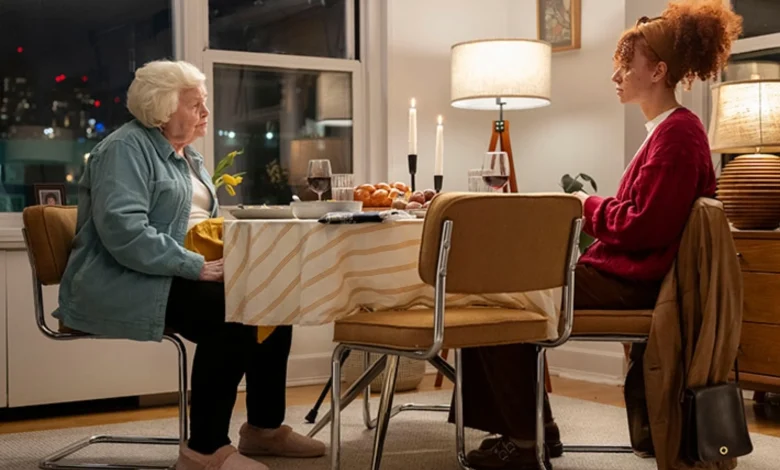‘Eleanor the Great’: A heartfelt look at aging and reinvention

Renowned actress Scarlett Johansson’s (“Lost in Translation”) directorial debut is an astounding story of how life’s phases interact. The film, “Eleanor the Great,” explores how youth and age, present and past, and happiness and tragedy all live amongst each other. The movie stars 95-year-old June Squibb (“Thelma”) as Eleanor, who lies about being a Holocaust survivor as she battles with the loss of her best friend Bessie (Rita Zohar, “Waterworld”). Forging new connections through her grief, we watch as Eleanor meets Nina (Erin Kellyman, “28 Years Later”) and the two quickly become friends, leaning on one another as they navigate grieving their lost loved ones.
“Eleanor the Great” attempts to encapsulate the experience of aging (both physically and emotionally) and coming to terms with one’s inner fears and desires. Johansson’s film represents this through raw, humane acting and depictions of internal and external tensions between characters. A large part of what makes the film so moving is the way it captures the power of small, human gestures. The film’s direction is astonishing, and makes the story feel very real while still maintaining its intensity throughout the entire runtime.
Insignificant moments in the film reveal a lot. Growing pains specifically are shown to be both physical and emotional, and these small moments are often used to show how emotional struggles can be physically felt, too. The strongest example of this comes from Nina, fiercely played by Kellyman, who initially encounters Eleanor in a business context, as Nina wants to cover Eleanor for her paper. Nina is essential to Eleanor’s growth as she, too, experiences the loss of somebody very close to her. Both women are perfect foils for one another, each representing a very real relationship with grief. As the film progresses, they learn to depend on each other to fill the hole left behind by Eleanor’s late friend and Nina’s late mother.
In one particularly moving scene, Nina, after losing her mom, wanders into her office and begins crying quietly, almost hyperventilating. The silence and pain grab the audience and take us down the path of her grief. Nina gasps for breath, reaching for a moment of clarity while throwing her hands above her head to escape the pain she is being thrown toward. The moment is devastatingly familiar for any of us who have experienced loss before. Kellyman’s performance feels gut-wrenchingly authentic, from her finger-fidgeting at a table in one scene to sitting in the bathroom with her leg shaking rapidly in another. Almost everyone who has experienced grief knows that overwhelmed foot tap, but rarely do we see this portrayal of emotion on screen so truthfully. These gestures bring reality to the film and allow the audience to see themselves in the characters. It represents the common human battle with grief and aging, reflecting how the two often go hand in hand.
The unsaid in this film also speaks volumes. In a scene demonstrating Eleanor’s growing willingness to move forward, Eleanor is placed in a warmly lit bedroom, the camera narrowing in on her hands as she places a photo of her and Nina above a framed picture of her and Bessie. While not much acting and expression is involved besides a slight smile, the scene still feels heart-warming. It is a thought-provoking reflection of the ways that the elderly find purpose in connecting with younger generations and, in turn, how these youth see that purpose from a new perspective.
In the scene, Eleanor sits alone in silence. An audience, when given silence, is allowed to fill that with their internal experience of the film. What immediately comes to mind in this moment is the growing relationship between Eleanor and Nina, the thought of replacing Bessie following uncomfortably after. When the camera closes in on one image being carefully placed in front of another, the audience’s focus is drawn to Eleanor’s advancement in her journey through grief and her two separate, yet oddly similar, relationships. Nina and Eleanor were introduced as two characters each looking to fill a void with the other, which makes their bond feel all-important. This also explains Eleanor’s need to lie to Nina, which stems from not wanting to disappoint her, protecting her newfound purpose.
There is even more effective symbolism in a moment where Eleanor’s daughter, Lisa (Jessica Hecht, “The Atlantic City Story”), sees her own aging reflection in a mirror. She cracks in this moment, recognizing her mother’s mortality and fears. The lighting is fiercely ordinary — a dimly lit bathroom, a face turned slightly down as it looks into the mirror. The camera is angled from behind, allowing the audience to truly see the actress recognize her own wrinkles and the “imperfections” that come with aging. The stillness of the camera allows the moment to resonate with the audience.
The cross-cutting sequence between Eleanor and Bessie is similarly powerful. The scene oscillates between a flashback of Bessie telling her story and the current moment of Eleanor retelling that story as if it were her own. The cut makes it excruciatingly clear that Eleanor literally stole her friend’s identity while battling with her grief, blurring the lines between truth and identity. The editing here is chilling. It was creepy how well Eleanor recited Bessie’s story, almost as if it truly were her own. It villainizes Eleanor, who was previously just an elderly woman who lost her best friend, yet it also allows the viewer to reflect on how it helps make her feel close to Bessie again.
“Eleanor the Great” is rich with strengths. In fact, one of the film’s only flaws is that it is too short. There is a lot of content and relationship development shoved into just 98 minutes, and the length of the movie forces the film’s exposition, climax and resolution to unfold too quickly. This was very noticeable toward the end of the movie, where it is quickly revealed that Eleanor has lied before she is rushed to an elderly living home and has a sweet reunion with Nina. In some ways, the beginning felt even more rushed. After getting close to Bessie’s character in the first ten minutes of the film, she dies, and Eleanor is suddenly on a flight to New York and a new life. We barely get a taste of Eleanor’s grief before it reveals itself through her lies later in the movie.
The film’s final message lands perfectly when Nina’s father appears on live television and pronounces, “Grief can make you blind to the suffering of others,” a sentiment that echoes across the whole narrative. In this way, one of the film’s final lines leaves the audience with a sense of curiosity surrounding the relationships formed during and because of grief.
With “Eleanor the Great,” Johansson delivers a powerful and deeply felt debut that touches on grief, aging and intergenerational connection. Regardless of what era of life you’re in now, you’ve surely felt growing pains, and watching Eleanor, Nina and the world around them experience theirs is sure to make you feel seen no matter who you are. I walked into the Michigan Theater expecting to be bored watching an elderly woman grapple with age, but instead I found myself deeply moved. I sat beside an elderly couple, and the three of us cried and laughed in unison at different moments in the film. If nothing else, that experience served for me as proof of how the film is able to capture an emotional experience that transcends age, gender and time.
Daily Arts Contributor Sofia Padilla can be reached at sofiapad@umich.edu.





